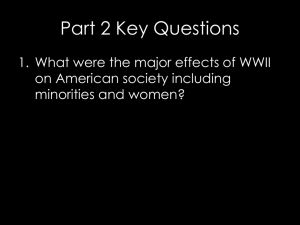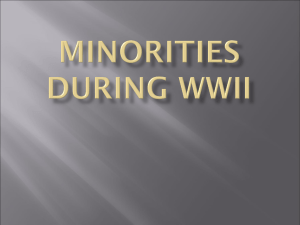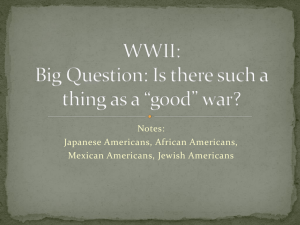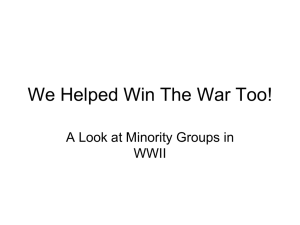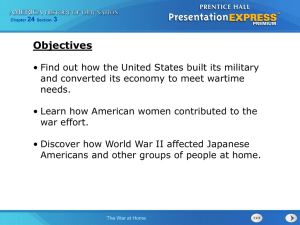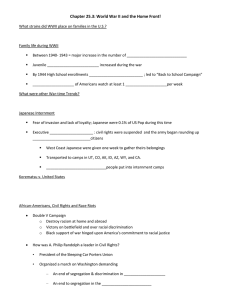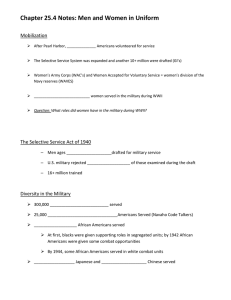The Home Front FOCUS QUESTION: What changes to society resulted
advertisement
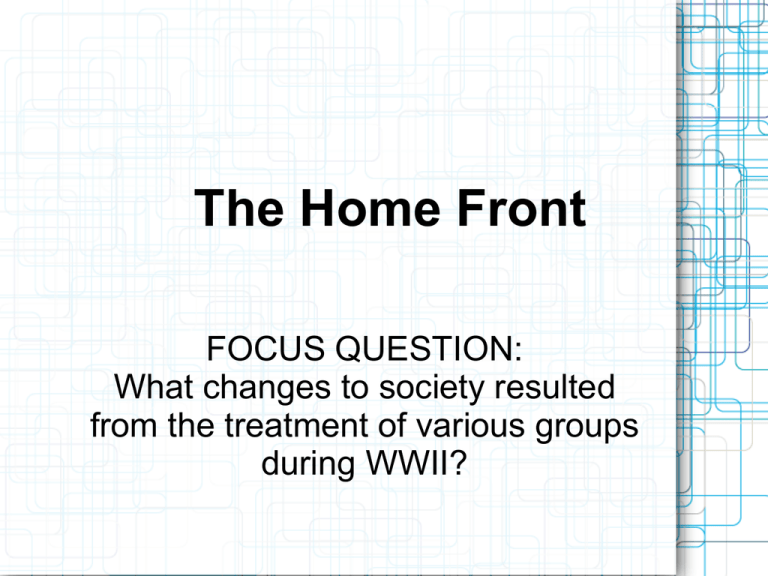
The Home Front FOCUS QUESTION: What changes to society resulted from the treatment of various groups during WWII? Women: joined women’s divisions of the military as photographers, nurses, code analysts, typists & switchboard operators (WACS and WAVES) Female War Photographer Women’s Army Air Corps Pilot “Rosie the Riveter” New job opportunities to women with men away at war – 4.5 million go to work Shipyards, steel mills, electricians, lawyers, doctors, etc. Helps to break down gender discrimination post-war Mexican Americans As many workers went off to war, there were intense labor shortages. Temporary workers from Puerto Rico and Mexico, or braceros, were brought in through the Bracero Program, a 1942 labor agreement between the United States and Mexico Zoot Suit Riots—received their name from the type of clothing, known as a “zoot suit,” worn by many young Mexican Americans. In the summer of 1943, a dispute between a Mexican American and a white man erupted into widespread rioting. A spree of attacking and beating Mexican Americans wherever they were found occurred afterward. African Americans during WWII Tuskegee Airmen—African American fighter pilots were trained as a part of the Army Air Force, but only at a segregated base located in Tuskegee, Alabama. A. Philip Randolph—led a protest against segregation in the armed forces and defense industries during the war. Randolph successfully threatened to bring thousands of blacks to protest in Washington, DC in 1941. It led FDR to issue Executive Order 8802, stating that there should be "no discrimination in the employment of workers in defense industries or Government because of race, creed, color, or national origin." The Committee on Fair Employment Practices was established to handle discrimination complaints. Race Riots—in 1943 African Americans rioted in Detroit, as well as in Harlem, NY and Columbia, TN. Af-Ams in Segregated Units Japanese Internment Feb 1942, FDR authorized the restriction & removal of civilian residents who were threats to national security Target: Japanese Americans 110,000 Japanese moved to detention camps on the west coast – lost homes & businesses Korematsu v. United States (1944) Supreme Court Case authorizing the internment camps, allowing the President to limit civil rights during wartime if necessary for national security “A Jap is a Jap. It makes no difference whether he is an American citizen or not” “At Gila, there were 7,700 people crowded into space designed for 5,000. They were housed in mess halls, recreation halls, and even latrines. As many as 25 persons lived in a space intended for four." “When we first arrived at Minidonka, everyone was forced to use outhouses since the sewer system had not been built. For about a year, the residents had to brave the cold and the stench of these accommodations." "In desert camps, the evacuees met severe extremes of temperature. In winter it reached 35 degrees below zero, and summer brought temperatures as high as 115 degrees. Rattlesnakes and desert wildlife added danger to discomfort." Consumers & the Office of Price Administration (OPA) Price controls & rationing – limited the amount of a product people could purchase Examples: gas, food, rubber, metal, cloth Convinced people to buy war bonds to finance the war “Use it up, wear it out, make it do or do without” Get Your Ration Cards The War Productions Board (WPB) • Offered businesses lucrative contracts for retooling for the war effort • Large commercial farmers also received incentives for war production • Labor unions offered “no strike pledges” for the duration of the war • Taxes were raised, bonds were sold and the general tax based was increased The Military By 1945, 11.7 million men & women on active duty 25,000 Native Americans & 1 million African Americans served in WWII Navajo “Code Talkers” War Propaganda & Censorship Government kept people of all ages committed to the war effort Examples: Victory Gardens Rationing Posters War films Soldier’s letters were screened Only pictures of enemy atrocities from war S..t..r..e..t..c..h That Food!
